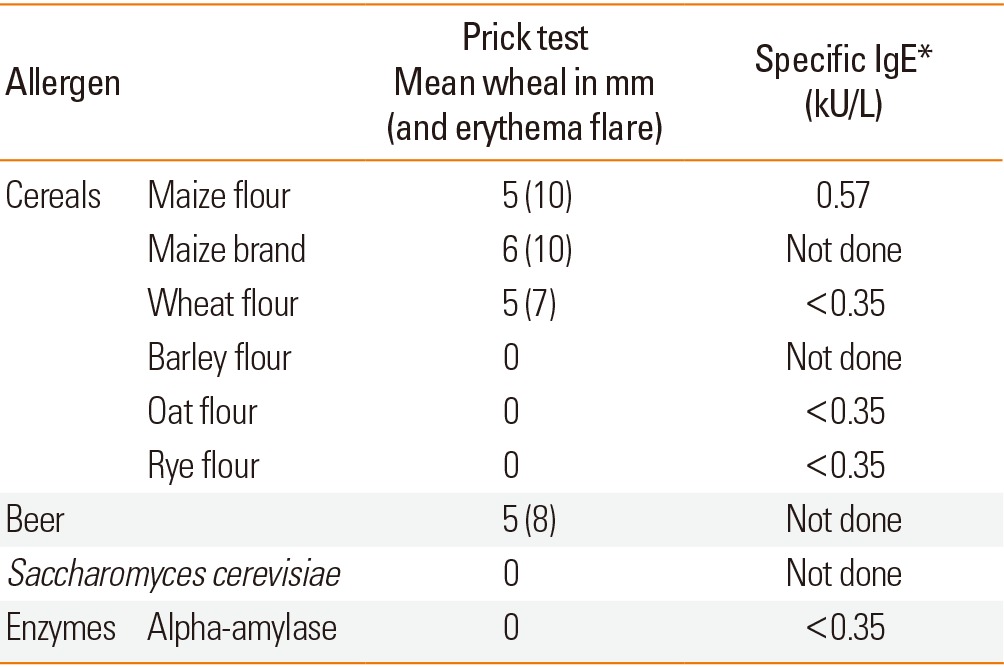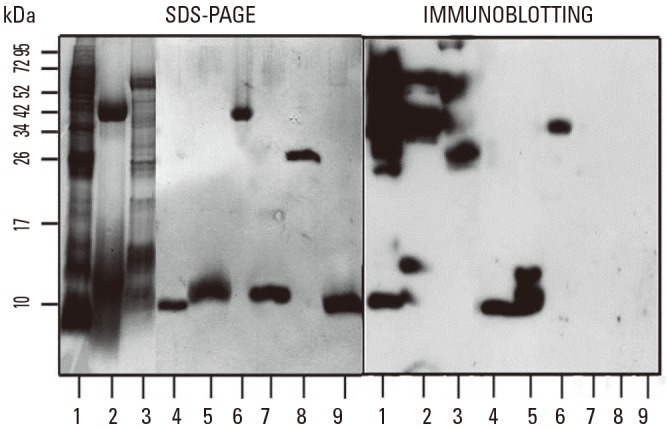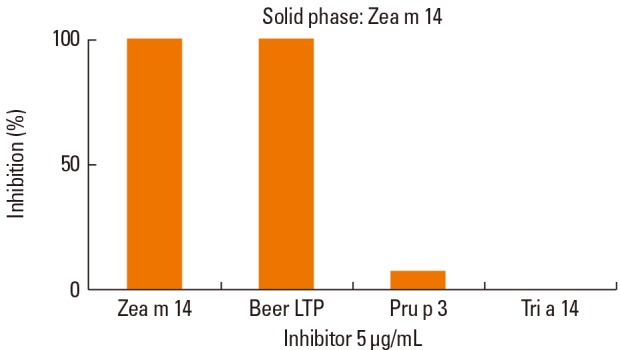Abstract
We report the case of a snack processor who developed occupational rhinoconjunctivitis due to maize brand exposure during the extrusion process, and who experienced abdominal pain upon drinking beer. The allergens implicated and the cross-reactivity between non-specific lipid transfer proteins (LTPs) from different cereals and peach were investigated. Skin prick tests and specific IgE to cereal flours, pulmonary functions tests and specific conjunctival and inhalation challenges to maize extract were performed. In vitro studies included IgE immunoblotting and ELISA inhibition assays. Skin prick tests with maize flour, maize brand and wheat flour extracts were positive, whereas serum specific IgE was positive only to maize flour. Specific inhalation challenge (SIC) to maize flour did not elicit an asthmatic reaction; however, conjunctival challenge test with the same extract was positive. Patient's serum recognized IgE-binding bands in the maize and beer extracts corresponding to LTPs. In the ELISA inhibition assays, a significant degree of allergenic cross-reactivity was found between maize and beer LTPs, whereas no cross-reactivity was observed between maize LTP and wheat and peach LTPs.
Go to : 
Maize (Zea mays) is a cereal commonly used in contemporary diet. Maize can give rise to allergy reactions upon ingestion,1 but also through inhalation of its flour2,3 or pollen.4,5
We describe a case of occupational rhinoconjunctivitis caused by maize brand in a snack processor who worked in the maize extrusion process. The allergens implicated as well as the existence of cross-reactivity between non-specific LTPs from different cereals and peach were investigated.
Go to : 
A 40-year-old man, a non-smoker, had worked as an operator in the production of cheese balls and worms by a maize extrusion process since he was 28 years old, manipulating cheese and maize brand several days a week. He had suffered from rhinoconjunctivitis and asthma symptoms at work for the last 6 months. These symptoms subsided on weekends and holidays. He was treated for acute asthma attacks in 2 occasions. He tolerated the intake of cheese and flour balls and worms, but he had experienced abdominal pain when he drank beer. The physical examination, chest X-ray and blood tests showed no abnormalities. Spirometry showed a FVC of 5.6 L (104.4% predicted), FEV1 of 3.86 L (87.8%), and FEV1/FVC 68.1%. The bronchodilator test was negative. He was relocated to a different area in his workplace and after 5 months of having stopped handling maize his symptoms markedly improved.
Skin prick tests (SPT) and specific IgE measurements were negative to pollen, mites, fungi and animal dander, as were to cow's milk proteins and S. cerevisiae. SPT showed positive results to maize flour, wheat flour and beer (Table 1). Total serum IgE was 94.20 kU/L. Specific IgE determinations (ImmunoCAP®, Thermo-Fisher, Sweden) were positive to maize flour extracts and negative to other cereal flours and alpha-amylase (Table 1).
The methacholine challenge test was positive (PC20 13.76 mg/mL) at work and negative (PC20>16 mg/mL) away from work. FeNO (NIOX MINO™, Aerocrine, Sweden) was 60 ppb while at work and 42 ppb away from work.
The SPT with the ingredients he handled at work were positive only with maize brand extract (10% wt/vol), being negative in five controls subjects. SIC to the maize brand extract was negative, whereas conjunctival challenge test6 with the same maize extract was positive.
Beer LTP used for the in vitro assays was obtained from commercial beer. Beer was degassed and then freeze-dried. Lyophilized beer was extracted with PBS buffer and precipitated with (NH4) 2SO4. The crude extract protein preparation was separated by cation-exchange chromatography on an Acell Plus CM Waters Sep-Pak cartridge. The fraction containing the LTP was repurified by reverse-phase HPLC. The N-terminal amino acid sequence of the 9-kDa protein (LNXGQVDS) was identical to the first 8 N-terminal residues of the LTP1 from barley seed.
The results of immunoblotting and ELISA-inhibition assays are shown in Fig. 1 and 2, respectively. In IgE-immunoblotting the patient's serum detected a low-molecular weight (MW) band in maize brand and beer extracts but not in the wheat flour extract. The patient's serum also showed IgE-binding to the maize and beer LTPs but not to the wheat and peach LTPs. Besides, other IgE-binding components (MW between 20-90 kDa) were recognized in the maize brand, beer and wheat extracts. The patient's serum also showed IgE binding to protein Z from beer.
In the ELISA inhibition assay using maize LTP (Zea m 14) extract as solid phase, and Zea m 14, beer LTP, Pru p 3 and wheat LTP (Tri a 14) as inhibitors, a 100% inhibition between Zea m 14 and beer LTP was found, but no inhibition of IgE-binding to Zea m 14 with Pru p 3 and Tri a 14 was observed.
Go to : 
We report on a case of occupational rhinoconjunctivitis due to maize brand with sensitization to LTPs (Zea m 14 and beer/barley LTP), which showed a high degree of allergic cross-reactivity. SIC to maize was negative, probably because the patient was relocated to a job position without exposure shortly after bronchial symptoms developed, and thus peak expiratory flow rate (PEFR) monitoring could not be performed. However, the positive conjunctival challenge test confirmed specific in vivo reactivity to maize brand.
Maize can cause IgE-mediated allergic reactions through inhalation of airborne particles, skin contact or ingestion. Respiratory symptoms caused by its pollen,4,5,7 occupational asthma and rhinoconjunctivitis due to its flour,2,3,8 contact urticaria,9 and food allergy due to maize ingestion1,10 have been reported.
Several IgE-binding proteins from maize have been related to different allergy reactions. A case of occupational rhinitis to maize pollen confirmed by nasal provocation test has been reported.3 Zea m 1 (β-expansin)3-5 has been identified as a major maize pollen allergen. Zea m 13 (poly-galacturonase) and Zea m 12 (profilin) are also pollen allergens.4 Zea m 14 (LTP) is a major food allergen,11 whereas α-amylase trypsin inhibitor7 and Zea m 25 (thioredoxin) are minor food allergens.12,13
A worker in a tablet manufacturing plant developed occupational allergy to a drug excipient containing maize starch.2 A 50-kDa allergen was identified in this worker2 as well as in patients with food allergy1 to maize. In our case it is assumed that the patient sensitization route was inhalation during the maize extrusion process.
Tri a 14 is a major allergen associated with baker' asthma14,15 and it has a high degree of cross-reactivity with Pru p 3.16 Pastorello et al.11 studied the cross-reactivity between Zea m 14, LTPs from other cereals and Pru p 3 in patients who had allergic reactions with the intake of maize and Prunoideae fruits. They observed cross reactivity between Zea m14 and Pru p3 and rice LTP, but not with Tri a 14 and barley LTP.
The patient herein reported showed IgE-mediated sensitization to maize flour and beer, as well as to wheat flour, and his circulating IgE recognized Zea m 14 and beer LTP, but not Tri a 14 or Pru p 3. The results of the ELISA-inhibition assays show complete inhibition of IgE-binding to Zea m 14 with beer LTP, indicating the existence of a large homology between these two LTPs, but no inhibition was observed with Pru p 3 and Tri a 14. Unlike the patients reported by Pastorello et al.,11 our patient had no symptoms with fruits. This discrepancy, however, is in agreement we the findings by Bernardi et al.17 on the great biochemical heterogeneity among LTPs. Our patient was also sensitized to protein Z and beer LTP, major allergens in beer,18 as well as to other proteins present in maize, beer, and wheat flour, that could correspond to other allergens related to food allergy to maize.19 Some of these proteins may be present in beer, such as the prolamines from maize called zeins: alpha-zein, precursor alphazein and a beta-zein; as well as the endochitinase precursor A and B.19 These latter proteins are chitinases that belong to the pathogenesis-related type 3 family (PR-3) and present significant homology with tomato endochitinase C (homology 58.4%) and with grape endochitinase IV (62% homology).19,20
In conclusion, this patient was sensitized to LTPs from both maize (Zea m 14) and beer that show a high degree of allergenic cross-reactivity, which has not been previously described.
Go to : 
References
1. Pasini G, Simonato B, Curioni A, Vincenzi S, Cristaudo A, Santucci B, Peruffo AD, Giannattasio M. IgE-mediated allergy to corn: a 50 kDa protein, belonging to the reduced soluble proteins, is a major allergen. Allergy. 2002; 57:98–106. PMID: 11929411.
2. Maniu CM, Faupel U, Siebenhaar G, Hunzelmann N. Maize: a new occupational allergen in the pharmaceutical industry. Allergy. 2010; 65:930–931. PMID: 20180793.

3. Sung SY, Lee WY, Yong SJ, Shin KC, Park HS, Kim HM, Kim SH. A case of occupational rhinitis induced by maize pollen exposure in a farmer: detection of IgE-binding components. Allergy Asthma Immunol Res. 2012; 4:49–51. PMID: 22211171.

4. Li LC, Bedinger PA, Volk C, Jones AD, Cosgrove DJ. Purification and characterization of four beta-expansins (Zea m 1 isoforms) from maize pollen. Plant Physiol. 2003; 132:2073–2085. PMID: 12913162.
5. Petersen A, Dresselhaus T, Grobe K, Becker WM. Proteome analysis of maize pollen for allergy-relevant components. Proteomics. 2006; 6:6317–6325. PMID: 17080481.

6. Abelson MB, Chambers WA, Smith LM. Conjunctival allergen challenge. A clinical approach to studying allergic conjunctivitis. Arch Ophthalmol. 1990; 108:84–88. PMID: 2297337.
7. Gonzalo-Garijo MA, Pérez-Calderón R, Muñoz-Rodríguez A, Tormo-Molina R, Silva-Palacios I. Hypersensitivity to maize pollen. Allergy. 2004; 59:365. PMID: 14982529.

8. Park HS, Nahm DH. Identification of IgE-binding components in occupational asthma caused by corn dust. Ann Allergy Asthma Immunol. 1997; 79:75–79. PMID: 9236505.

9. Cristaudo A, Simonato B, Pasini G, De Rocco M, Curioni A, Giannattasio M. Contact urticaria and protein contact dermatitis from corn in a patient with serum IgE specific for a salt-soluble corn protein of low molecular weight. Contact Dermatitis. 2004; 51:84–87. PMID: 15373849.

10. Scibilia J, Pastorello EA, Zisa G, Ottolenghi A, Ballmer-Weber B, Pravettoni V, Scovena E, Robino A, Ortolani C. Maize food allergy: a double-blind placebo-controlled study. Clin Exp Allergy. 2008; 38:1943–1949. PMID: 18778272.

11. Pastorello EA, Farioli L, Pravettoni V, Ispano M, Scibola E, Trambaioli C, Giuffrida MG, Ansaloni R, Godovac-Zimmermann J, Conti A, Fortunato D, Ortolani C. The maize major allergen, which is responsible for food-induced allergic reactions, is a lipid transfer protein. J Allergy Clin Immunol. 2000; 106:744–751. PMID: 11031346.

12. Weichel M, Vergoossen NJ, Bonomi S, Scibilia J, Ortolani C, Ballmer-Weber BK, Pastorello EA, Crameri R. Screening the allergenic repertoires of wheat and maize with sera from double-blind, placebo-controlled food challenge positive patients. Allergy. 2006; 61:128–135. PMID: 16364168.

13. Fasoli E, Pastorello EA, Farioli L, Scibilia J, Aldini G, Carini M, Marocco A, Boschetti E, Righetti PG. Searching for allergens in maize kernels via proteomic tools. J Proteomics. 2009; 72:501–510. PMID: 19367736.

14. Palacin A, Quirce S, Armentia A, Fernández-Nieto M, Pacios LF, Asensio T, Sastre J, Diaz-Perales A, Salcedo G. Wheat lipid transfer protein is a major allergen associated with Baker's asthma. J Allergy Clin Immunol. 2007; 120:1132–1138. PMID: 17716720.

15. Quirce S, Diaz-Perales A. Diagnosis and management of grain-induced asthma. Allergy Asthma Immunol Res. 2013; 5:348–356. PMID: 24179680.

16. Tordesillas L, Pacios LF, Palacin A, Quirce S, Armentia A, Barber D, Salcedo G, Diaz-Perales A. Molecular basis of allergen cross-reactivity: non-specific lipid transfer proteins from wheat flour and peach fruit as models. Mol Immunol. 2009; 47:534–540. PMID: 19846220.

17. Bernardi ML, Giangrieco I, Camardella L, Ferrara R, Palazzo P, Panico MR, Crescenzo R, Carratore V, Zennaro D, Liso M, Santoro M, Zuzzi S, Tamburrini M, Ciardiello MA, Mari A. Allergenic lipid transfer proteins from plant-derived foods do not immunologically and clinically behave homogeneously: the kiwifruit LTP as a model. PLoS One. 2011; 6:e27856. PMID: 22114713.

18. García-Casado G, Crespo JF, Rodríguez J, Salcedo G. Isolation and characterization of barley lipid transfer protein and protein Z as beer allergens. J Allergy Clin Immunol. 2001; 108:647–649. PMID: 11590395.

19. Pastorello EA, Farioli L, Pravettoni V, Scibilia J, Conti A, Fortunato D, Borgonovo L, Bonomi S, Primavesi L, Ballmer-Weber B. Maize food allergy: lipid-transfer proteins, endochitinases, and alpha-zein precursor are relevant maize allergens in double-blind placebo-controlled maize-challenge-positive patients. Anal Bioanal Chem. 2009; 395:93–102. PMID: 19669736.

20. Pastorello EA, Pompei C, Pravettoni V, Farioli L, Calamari AM, Scibilia J, Robino AM, Conti A, Iametti S, Fortunato D, Bonomi S, Ortolani C. Lipid-transfer protein is the major maize allergen maintaining IgE-binding activity after cooking at 100 degrees C, as demonstrated in anaphylactic patients and patients with positive double-blind, placebo-controlled food challenge results. J Allergy Clin Immunol. 2003; 112:775–783. PMID: 14564361.
Go to : 




 PDF
PDF ePub
ePub Citation
Citation Print
Print





 XML Download
XML Download